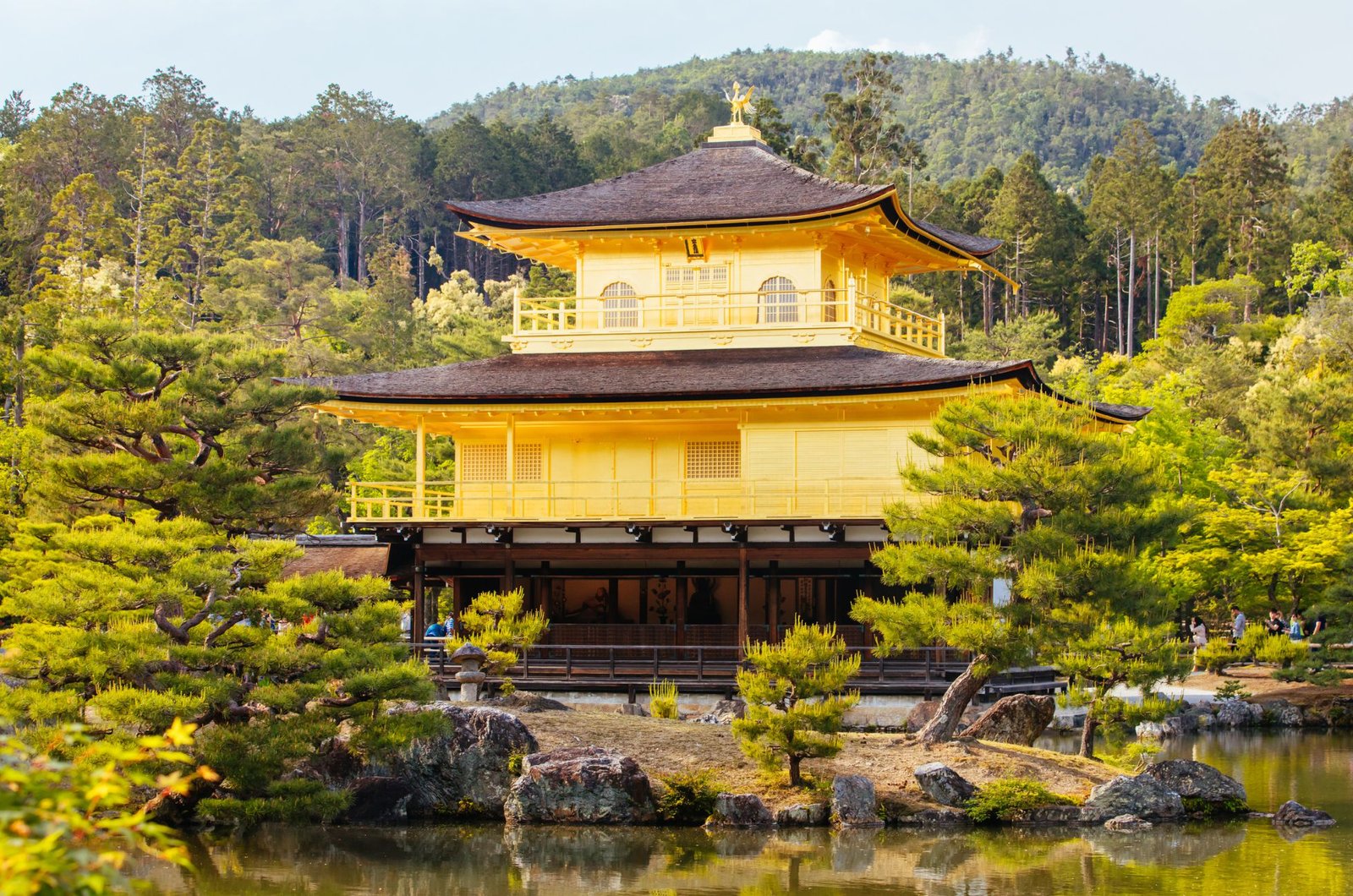Kyoto, once the imperial capital of Japan, continues to shine as the nation’s spiritual and cultural heart. Housing over 2,000 temples and shrines offers an unmatched opportunity to witness the legacy of Japanese tradition, architecture, and religion in one compact city.
The Kyoto temple travel guide is your roadmap to the city’s most iconic spiritual landmarks. Whether you’re a first-time visitor or returning for a deeper exploration, this guide will help you prioritize the best temples in Kyoto, understand proper etiquette, and experience the magic of cherry blossoms and autumn foliage at the right time.
Expect everything you need to plan an unforgettable cultural journey.
Where To Stay In Kyoto
Kyoto’s diverse accommodations provide both convenience and cultural depth. From luxury hotels to traditional inns, here are four excellent options:
- Ryokan Genhouin: Offers an intimate glimpse into Japanese hospitality. Set within a peaceful garden, this inn blends elegance with authenticity.
- The Celestine Kyoto Gion: Nestled in Gion, this hotel fuses traditional style with modern luxury. Perfect for temple-hopping on foot.
- Good Nature Hotel Kyoto: Prioritizing sustainability and wellness, this eco-conscious hotel enhances your travel experience with organic dining and a relaxing atmosphere.
- Hotel Keihan Kyoto Grande: Strategically located near Kyoto Station, this is the most convenient choice for day trips and city exploration.
Choosing where to stay greatly influences your daily itinerary, making proximity to temples and transportation essential for stress-free travel.
Best Traditional Shrines & Temples in Kyoto, Japan
With over 2,000 shrines and temples, Kyoto offers an unmatched window into Japan’s religious and architectural legacy. Narrowing down the best temples in Kyoto can feel overwhelming, but several locations stand out for their historical depth, stunning aesthetics, and spiritual atmosphere.
This guide presents the top traditional sites, combining concise insights, visitor tips, and cultural highlights.
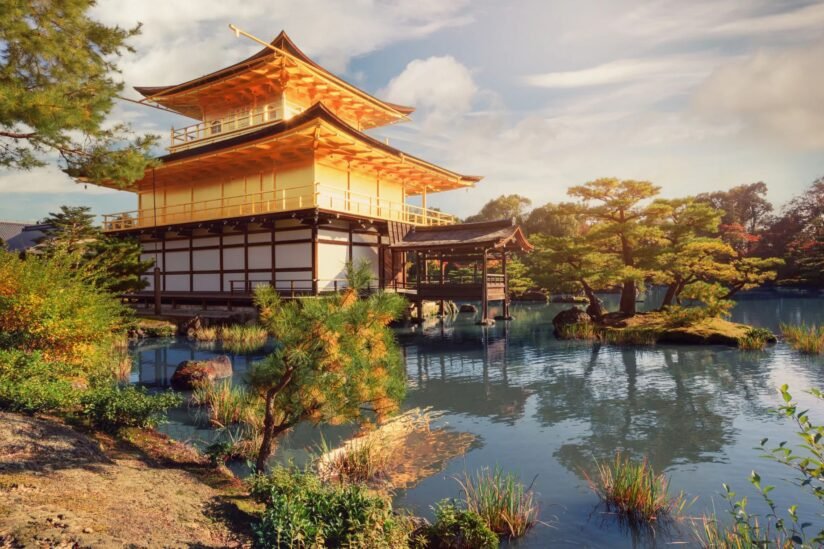
Kinkaku-ji Temple (Golden Pavilion)
Perhaps the most iconic Kinkaku-ji—known as the Golden Pavilion—reflects Kyoto’s elegance and spiritual beauty.
- UNESCO World Heritage site
- Covered in genuine gold leaf, mirroring its brilliance over a still pond
- Located in northern Kyoto, easily accessible by bus
- Surrounded by beautifully maintained gardens
The best time to visit is early morning when the reflection on the water is most vivid and the crowds are minimal. As one of the most photographed landmarks in Japan, Kinkaku-ji embodies both serenity and spectacle.
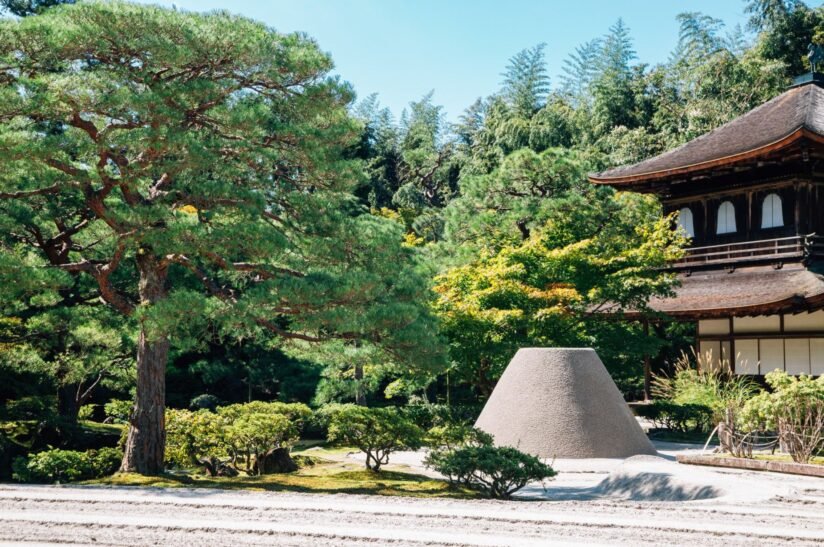
Ginkaku-ji Temple (Silver Pavilion)
In contrast to its golden counterpart, Ginkaku-ji offers a quieter, more reflective experience.
- Located in Kyoto’s Higashiyama district
- Designed by Shogun Ashikaga Yoshimasa as a retreat
- Features the famous “Sea of Silver Sand” and the meticulously shaped sand cone representing Mt. Fuji
- Surrounded by a moss garden and a walking path that offers panoramic views
Though never coated in silver, Ginkaku-ji’s minimalist Zen design studies wabi-sabi, the beauty of imperfection and simplicity.
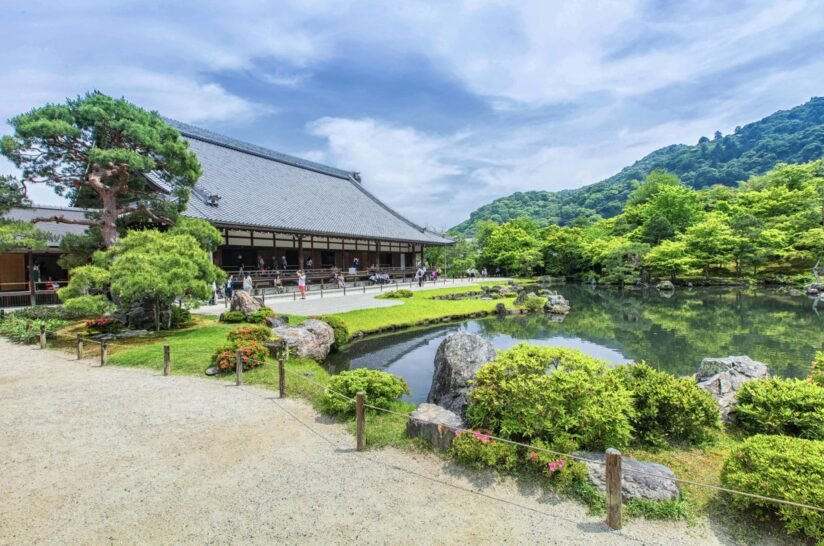
Tenryu-ji Temple
Situated in the scenic Arashiyama district, Tenryu-ji is one of Kyoto’s most important Zen temples.
- A UNESCO World Heritage site
- Features an exquisite landscape garden that dates back to the 14th century
- Located near the Arashiyama Bamboo Grove
- Best visited in autumn for vibrant red and orange foliage
Tenryu-ji combines spiritual gravitas with natural beauty. The temple’s garden, designed to reflect the surrounding mountains, exemplifies Japanese landscape design.
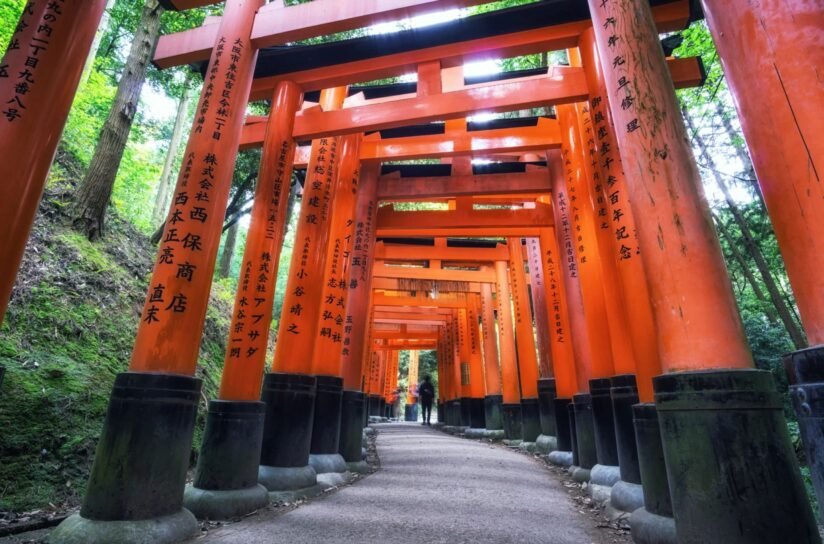
Fushimi Inari Shrine
One of Japan’s most visited religious sites, Fushimi Inari Shrine is unmistakable for its 10,000+ vermilion torii gates.
- Dedicated to Inari, the Shinto god of rice and prosperity
- Located at the base of Mount Inari
- A hike to the summit takes 2–3 hours and offers scenic viewpoints
To avoid crowds, visit early in the morning or just before sunset. The winding trails and endless gates make this one of Kyoto’s most spiritually immersive experiences.
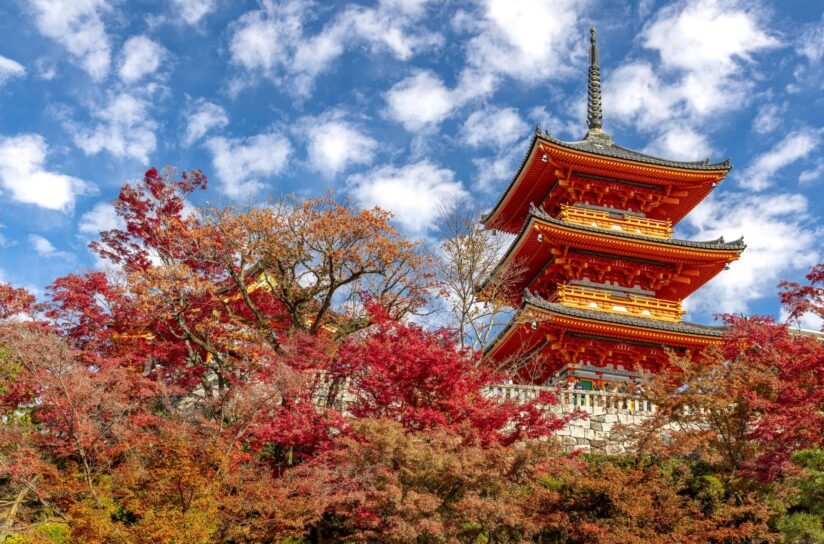
Kiyomizu-dera Temple
A cultural icon and one of the most visited sites in Kyoto, Kiyomizu-dera offers history, architecture, and dramatic city views.
- Established in 778 AD
- Known for its large wooden stage extending from the main hall
- Offers spectacular views during the cherry blossom season and autumn foliage
- Features the Otowa Waterfall, where visitors drink from three streams for health, longevity, and success
Kiyomizu-dera means “Pure Water Temple” and is beloved for its vibrant pagodas and panoramic outlook over Kyoto.
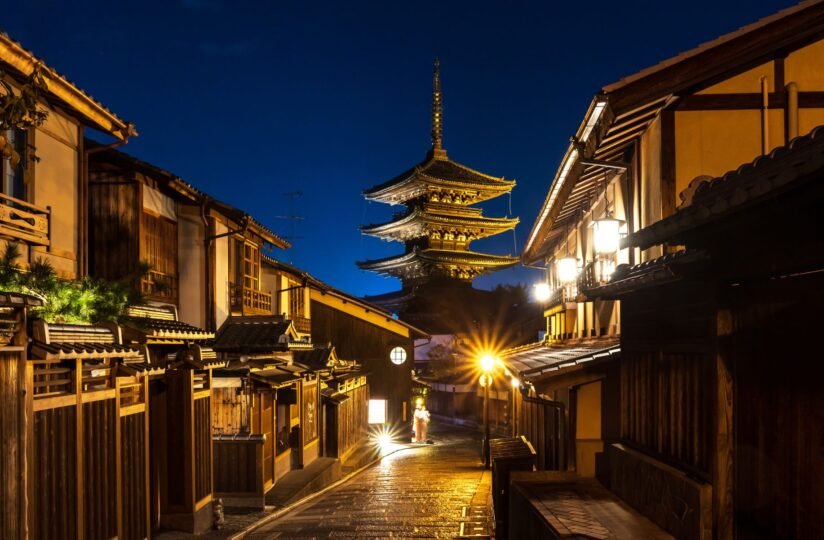
Yasaka Pagoda (Hōkan-ji Temple)
A landmark structure rising from the historic streets of Higashiyama, the Yasaka Pagoda is both elegant and historically significant.
- A five-story pagoda dating back to the 15th century
- Initially built in the 6th century
- One of the few pagodas in Japan that visitors can climb to the second floor
Surrounded by traditional machiya (wooden townhouses), Yasaka Pagoda is a favourite photo spot and a serene detour from nearby bustling streets.
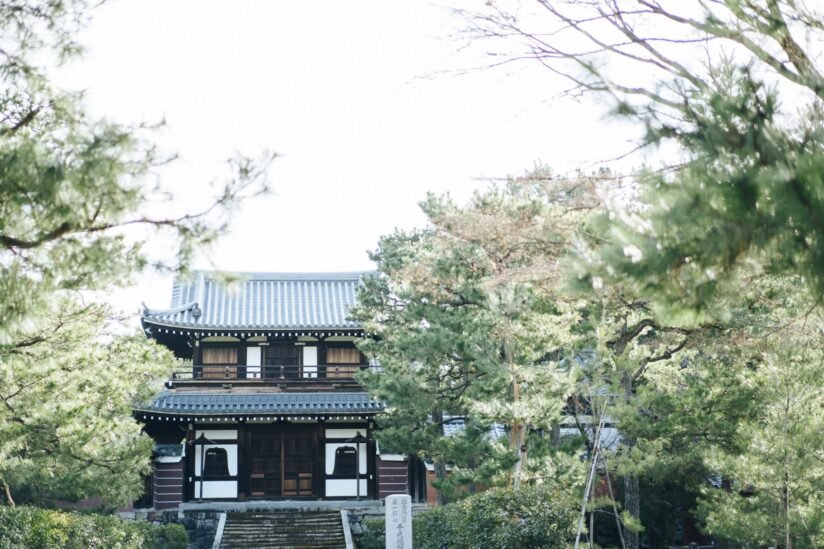
Kennin-ji Temple
As Kyoto’s oldest Zen temple, Kennin-ji is a cornerstone of Japanese Zen Buddhism.
- Founded in 1202 AD
- Located near Gion, in central Kyoto
- Known for its austere architecture, raked rock gardens, and famous screen paintings like “The Wind and Thunder Gods”
- Ideal for meditation and quiet reflection
Unlike more flamboyant temples, Kennin-ji offers a subdued, contemplative environment. Its simplicity invites inner calm and spiritual focus.

Byodo-in Temple (Uji)
A short train ride from central Kyoto, Byodo-in is one of Japan’s most beautiful temples and is rich in cultural symbolism.
- Located in Uji, a city famous for green tea
- The Phoenix Hall is a designated National Treasure
- Featured on the Japanese 10-yen coin
- A museum on-site houses original artefacts and Buddhist statues
Byodo-in’s reflection over the pond creates a symmetrical, almost ethereal beauty. A replica in Hawaii shows its cultural significance even overseas.
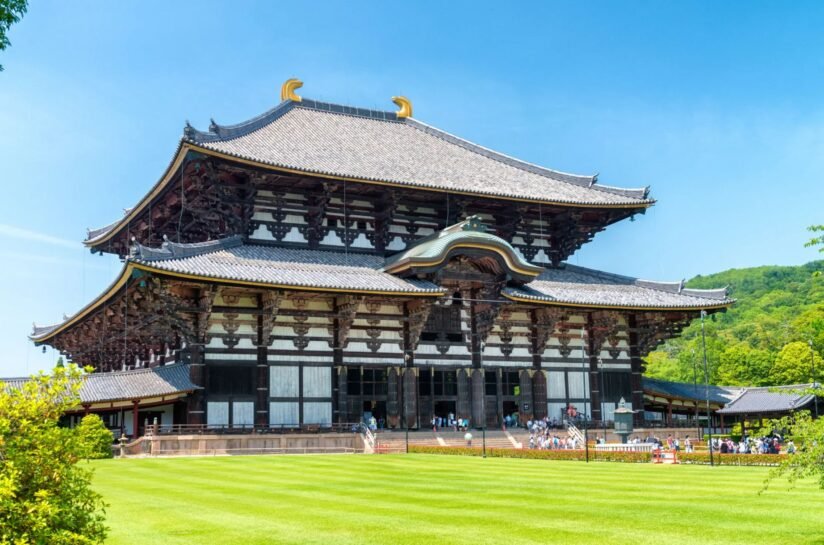
Tōdai-ji Temple (Nara)
While not technically in Kyoto, Tōdai-ji in nearby Nara is a popular day trip and an unmissable destination for temple enthusiasts.
- Home to the Great Buddha Hall, one of the world’s most significant wooden buildings
- Houses the Daibutsu, the world’s largest bronze Buddha
- Located in Nara Park, where tame deer roam freely
- A UNESCO World Heritage site
The combination of monumental architecture and freely wandering deer gives Tōdai-ji a unique and memorable atmosphere.
Key Tips for Visiting Kyoto’s Temples and Shrines
To get the most from your visit, keep the following tips in mind:
- Go early or late: Popular temples like Fushimi Inari and Kinkaku-ji draw large crowds by midday.
- Dress respectfully: While not strictly enforced, modest attire is appreciated.
- Plan geographically: Cluster visits to save time. For example, Ginkaku-ji, Yasaka Pagoda, and Kiyomizu-dera are all in the Higashiyama area.
- Using a Kyoto City Bus Pass makes getting around cost-effective and efficient.
Understanding the Cultural Significance
Each of these temples and shrines offers insight into different aspects of Japanese culture:
- Zen temples like Kennin-ji and Tenryu-ji focus on meditation and simplicity.
- Shinto shrines like Fushimi Inari celebrate nature, prosperity, and local deities.
- Architectural marvels like Kinkaku-ji and Byodo-in showcase historical craftsmanship and religious symbolism.
Exploring the best temples in Kyoto is more than a sightseeing checklist—it’s a cultural and spiritual journey. Whether you’re admiring the golden brilliance of Kinkaku-ji, walking through the torii tunnels at Fushimi Inari, or reflecting in the peaceful gardens of Ginkaku-ji, each site tells a story of faith, artistry, and tradition.
By prioritizing the standout locations listed above, you’ll experience the essence of Kyoto’s historical and spiritual landscape—deeply rooted, visually stunning, and spiritually enriching.
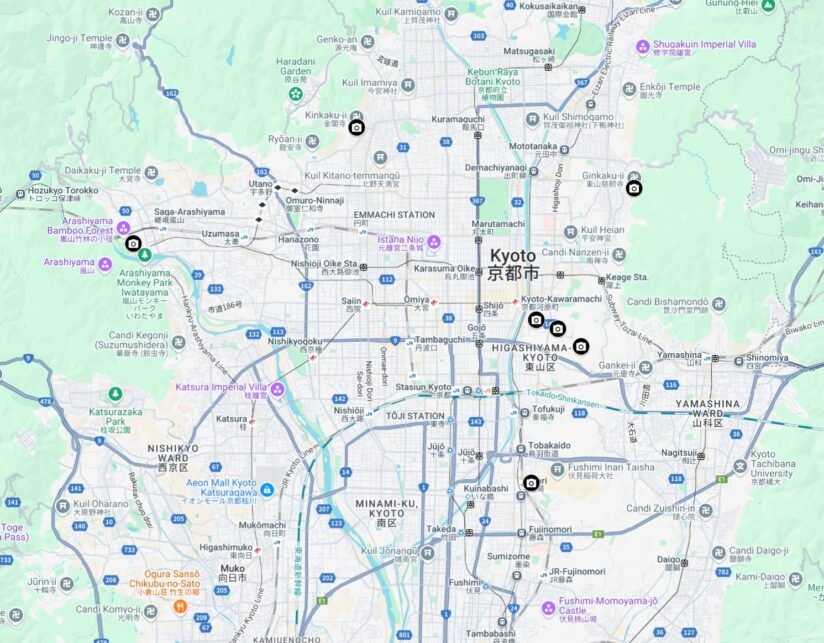
Kyoto Temple Map
Navigating Kyoto’s spiritual landscape with digital tools, optimizing time and experience, is easier.
Interactive Map Resources
- Kyoto Smart Navi: Real-time congestion updates make it easier to avoid crowds.
- InsideKyoto.com: Offers a user-friendly map with colour-coded locations.
- Kyoto City Official Travel Guide: Includes downloadable maps for offline use.
These tools help prioritize temple routes, locate nearby accommodations, and identify transport options. If you’re short on time, maps allow you to plan routes that combine several of the best temples in Kyoto within a day.
Japanese Temple Etiquette
Understanding proper behaviour at religious sites enhances your experience and shows respect to local traditions.
General Guidelines
- Speak quietly and keep noise to a minimum.
- Remove shoes when entering temple buildings.
- No photography in sacred areas—follow signage.
- Wear modest clothing covering shoulders and knees.
- Pay small entry fees (under ¥500) when required.
- Kimono rental is both respectful and encouraged.
At Shrines (Shinto)
- Bow at the torii gate before entering.
- Clean hands and mouth at the chozuya (water basin).
- Ritual: Offer a coin → Ring the bell → Bow twice → Clap → Pray → Bow once
At Temples (Buddhist)
- Offer incense, but don’t light from another person’s stick.
- Silent prayer is customary after bowing and offering a coin.
Following these etiquette rules shows respect and enhances your appreciation of the spiritual atmosphere.
Best Time To Visit
The timing of your trip significantly impacts your Kyoto experience. From delicate cherry blossoms to fiery autumn leaves, seasonal changes transform the temple landscape.
Cherry Blossom Season
- Typically occurs late March to early April
- Full bloom around April 1
- Visit temples like Kiyomizu-dera, Daigo-ji, and Heian Shrine
- Mornings offer a peaceful ambience and perfect lighting
Autumn Foliage
- Best seen mid-November to early December
- Tenryu-ji and Rurikō-in are top choices
- Crisp air and fewer tourists enhance photo opportunities
Optimal Times of Day
- Early mornings (8–10 AM) and late afternoons (4–6 PM) are best
- Avoid tour bus hours (11 AM–3 PM) for a tranquil visit
Understanding Kyoto’s seasonal shifts adds depth to your temple visits, allowing you to capture the city’s magic in its most captivating form.
Wrap-up
Kyoto temple travel guide is more than a sightseeing checklist—it immerses you into Japan’s living heritage. Each location, from towering pagodas to serene gardens, reveals stories of devotion, design, and the deep spiritual ties that shape Japanese identity.
Respecting Kyoto shrine etiquette, using maps for efficient planning, and timing your visits during cherry blossom or autumn foliage seasons will elevate your journey beyond typical tourism.
Embrace Kyoto with your camera, cultural curiosity, and a respectful heart. Your steps through its ancient paths will echo far beyond the moment.
FAQ’s
- How many temples are there in Kyoto?
Over 2,000 temples and shrines in Kyoto, ranging from grand UNESCO sites to hidden neighbourhood gems. - Do I need to book tickets in advance?
Most temples don’t require booking. However, popular sites may offer optional online reservations for guided tours. - What’s the difference between a shrine and a temple in Kyoto?
Shrines are Shinto, marked by torii gates, while temples are Buddhist and usually include incense and large halls. - Can I wear a kimono when visiting temples?
Wearing a kimono is culturally appreciated and often enhances the spiritual experience. - Are the Kyoto temples child-friendly?
Many temples have open spaces and gardens, though some may restrict access to specific halls. - How long should I spend at each temple?
Typically, 30 minutes to an hour per temple is ideal, depending on interest and size. - Are the temples open year-round?
Most temples are open throughout the year, with seasonal highlights in spring and autumn. - Can I use public transport to visit these temples?
Absolutely. Kyoto’s bus and train systems are efficient and connect well to central temple districts. - Do Kyoto temples offer English information?
Major temples provide English signage and brochures. Some even offer guided tours. - Is there a dress code for visiting temples in Kyoto?
While there’s no strict dress code, modest clothing is expected out of respect.
